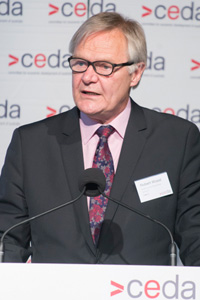PROGRESS 2050: Toward a prosperous future for all Australians
31/10/2012
 |
|
 |
|
 |
|
 |
Progress is being made towards the Government's target of 40 per cent representation of women on government boards by 2015 a CEDA audience in Melbourne has heard.
Minister for the Status of Women, Julie Collins launched the Gender Balance on Australian Government Boards Report 2011-2012, which revealed an increase of 3.1 per cent on last year's results.
"As at June, the percentage of women on Government boards was 38.4 per cent," she said.
The report also shows that eight portfolios have now achieved the 40 per cent target, double the number of boards who reached the target in the previous financial year, she said.
Ms Collins said women in leadership is more than prescribing certain behaviours, "it's also about creating long-term and sustainable cultural change - in both the public and private spheres".
"It is about normalising the multiple roles that both women and men have as workers, carers, leaders and active participants in our communities," she said.
Ms Collins said the Government has made policy improvements and significant investments to drive better economic and social outcomes for women, including reforming the Equal Opportunity for Women in the Workplace Act.
One of the key findings from the consultation process of the Equal Opportunity for Women in the Workplace Act was that the activities of the Equal Opportunity for Women in the Workplace Agency (EOWA) need to focus on influencing change of behaviour in organisations, Ms Collins said.
"Submissions from industry, government and the community sectors preferred cultural change and education solutions above all others," she said.
"It became clear when we developed the Regulation Impact Statement that market forces unaided cannot ensure workplace gender equality.
"The magnitude, the history and extent of the issue underscored the likelihood that a voluntary regime would not work.
"The reforms retain the existing level of regulation, while putting a keen focus on outcomes, education and assistance with sanctions being a last resort.
"They do this by balancing the potential for short term progress while maintaining strong lines of communication and persuasion essential to sustain the change.
"We need to see cultural changes in workplaces and in society generally and it's up to all of us to drive and support change."
Ms Collins said under the reforms, businesses will no longer have to provide a descriptive report on their policies and programs, but rather on the indicators that matter, including:
- The actual figures of the gender composition of their organisations and boards;
- Their employment conditions including remuneration; and
- Whether they have flexible work practices for women and men.
Ms Collins added that early indicators from the Census of Women in Leadership from the Equal Opportunity Workplace Agency are that organisations are continuing to overlook the female pool of talent.
"There are many laudable corporate organisations and individuals and their numbers are growing - but not fast enough," she said.
Melbourne Business School, Centre for Ethical Leadership, Director, Professor Robert Wood said increasing women's participation is leadership positions, and the workplace in general, is a productivity issue.
"When we think about investments in the education, training and development of women up to the age of 30, which is when the drop out begins, we need to ask the question can we do more to get higher returns on this investment and improve the productivity of our organisations and the Australian economy?" he said.
Professor Wood said if similar investment yardsticks were used for the effective utilisation of people over their work life, "we might see more imaginative strategies to retain women in the workforce and better utilise their skills at more senior levels."
Though there have been equal proportions of male and female graduate recruits for many years, "by the time the cohort reaches partnership or executive level that 50 per cent has dwindled to around 20 per cent," he said.
"In most organisations, the proportion of women in the upper middle management and executive ranks is less than 10 per cent.
"While research is unequivocal on the benefits of diversity, the problem is it has very little to say about the impacts that the means by which we achieve diversity have on the outcomes it produces.
"What we do know is that traditional practices will not lead to significant increases in the numbers of women in leadership roles anytime in the next 20 years."
Professor Wood acknowledged that the proposed use of quotas for women in leadership roles evokes strong emotional responses and there are many arguments for and against the use of quotas.
He said the common arguments against the quotas ignore the effects of unconscious bias and it often masks a lack of strategic imagination about how things could be improved.
"Unconscious bias may mean that we do not see the women who are there," she said.
Professor Wood closed with a recommendation to the Minister: "I would give the ASX policy another three years and encourage companies to start reporting specific, measurable and moderately challenging targets for mid-level and senior executives as well as boards and also reporting on their progress against them."
"If there is not significant improvement by 2015, then I would recommend that you introduce quotas," he said.
